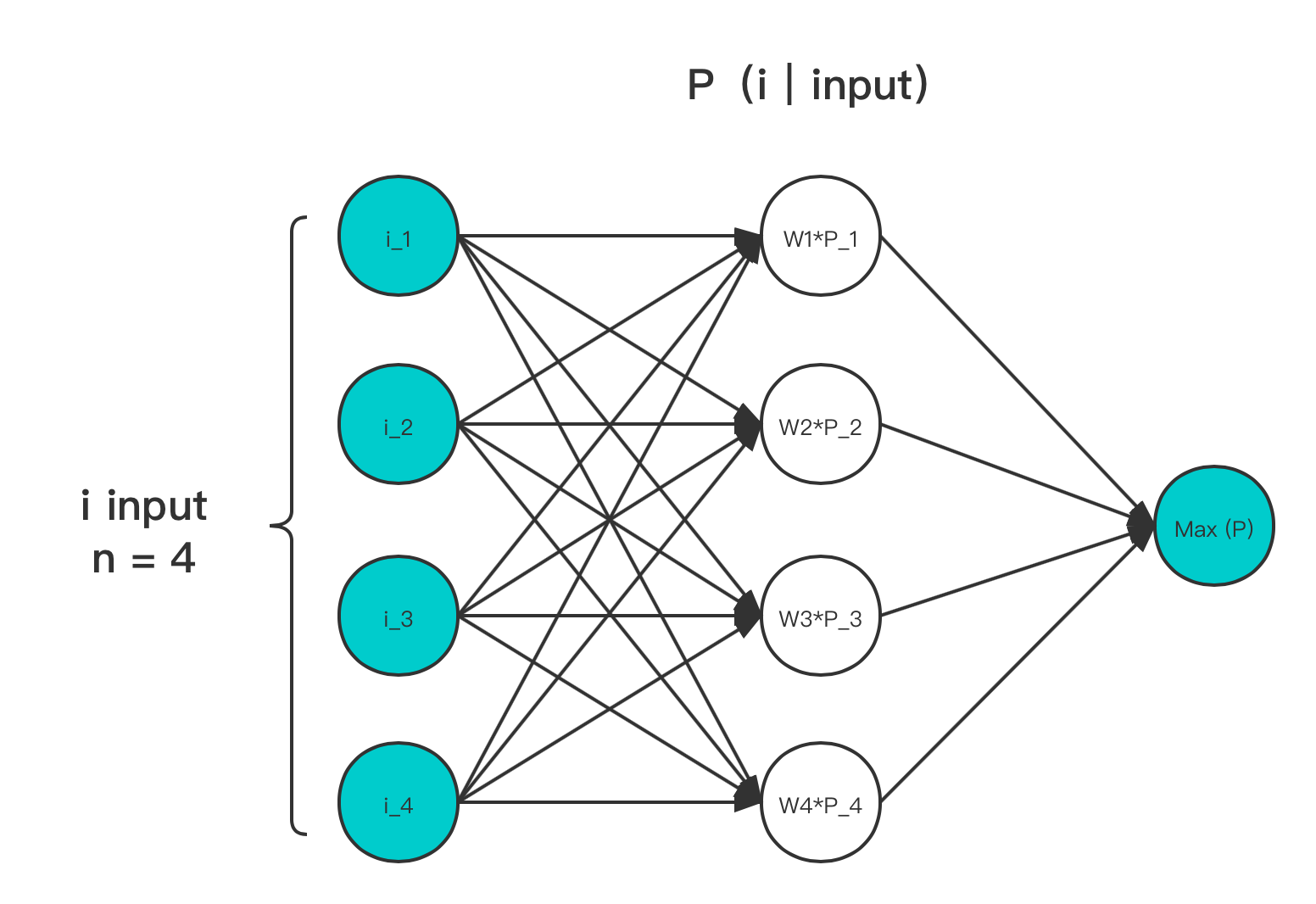4.4.3 Softmax
迭代公式:
迭代公式( log 版本,log-Softmax):
迭代公式( stable 版本,stable-Softmax):
迭代公式( stable-log 结合版本,stable-log-Softmax):
图像:

图 4-22 Softmax 输入输出作用示意图
特性:
- Softmax 能够起到归一化作用,将输入变换到输出范围在 [ 0, 1 ] 之间
- 输出满足概率累和为 1
- 求最大值过程非稀疏化
- 只增加了一层用于概率映射的隐藏层,增加了 input 个参数
- Softmax 存在大指数输入导致的数值稳定性问题
- log-Softmax 少了除法,相对数值更加稳定
- stable-Softmax 对指数做了差值限定,但因为除法,可能会导致除零问题
- stable-log-Softmax 有 stable 和 log 两者的优点,且无除零问题,但略微增加消耗
Softmax 常用于多目标分类、目标预测、NLP领域。能够将数字特征映射到概率范围内。常用在全联接层后,并配合 Cross-Entropy 损失函数使用。
目前 Softmax 的多种变体中,被使用最多的还是 stable-log-Softmax ,且涵盖了 log-Softmax 的相关情况。因此,一般将 stable-log-Softmax 和 log-Softmax ,统一称为 log-Softmax。
Softmax 被广泛使用的原因,还是在于它自带归一化,且能够稳定神经元的功能。这使得用 Softmax 做链接层算子,能够在分类场景上,更快的达到期望结果。是提升训练速率的有效手段。
Softmax 算子化
利用 C 语言实现对算子的封装,有:
#include <math.h>
#include <stdio.h>
double ori_softmax(double *x, int size) {
double sum = 0;
for (int i = 0; i < size; i++) {
sum += exp(x[i]);
}
double y = exp(x[0]) / sum;
for (int i = 1; i < size; i++) {
y += exp(x[i]) / sum;
}
return y;
}
double ori_log_softmax(double *x, int size) {
double sum = 0;
for (int i = 0; i < size; i++) {
sum += exp(x[i]);
}
double y = x[0] - log(sum);
for (int i = 1; i < size; i++) {
y += x[i] - log(sum);
}
return y;
}
double softmax(double *x, int size) {
double max_value = x[0];
for (int i = 1; i < size; i++) {
if (x[i] > max_value) {
max_value = x[i];
}
}
double sum = 0;
for (int i = 0; i < size; i++) {
sum += exp(x[i] - max_value);
}
double y = exp(x[0] - max_value) / (sum);
for (int i = 1; i < size; i++) {
y += exp(x[i] - max_value) / (sum);
}
return y;
}
double log_softmax(double *x, int size) {
double max_value = x[0];
for (int i = 1; i < size; i++) {
if (x[i] > max_value) {
max_value = x[i];
}
}
double sum = 0;
for (int i = 0; i < size; i++) {
sum += exp(x[i] - max_value);
}
double y = (x[0] - max_value) - log(sum);
for (int i = 1; i < size; i++) {
y += (x[i] - max_value) - log(sum);
}
return y;
}
int main() {
// Softmax
{
int size = 3;
double vecx[] = {0.5, 0.75, 1.0};
double w = ori_softmax(vecx, size);
printf("The softmax of the input vector is %f\n", w);
}
// log-Softmax
{
int size = 3;
double vecx[] = {0.5, 0.75, 1.0};
double w = ori_log_softmax(vecx, size);
printf("The log-softmax of the input vector is %f\n", w);
}
// stable-Softmax, which we use most as Softmax
{
int size = 3;
double vecx[] = {0.5, 0.75, 1.0};
double w = softmax(vecx, size);
printf("The stable-softmax of the input vector is %f\n", w);
}
// log-stable-Softmax, which we use most as log-Softmax
{
int size = 3;
double vecx[] = {0.5, 0.75, 1.0};
double w = log_softmax(vecx, size);
printf("The log-stable-softmax of the input vector is %f\n", w);
}
return 0;
}
运行验证可得到结果:
The softmax of the input vector is 0.244728
The log-softmax of the input vector is -1.401880
The stable-softmax of the input vector is 0.244728
The log-stable-softmax of the input vector is -1.401880
和理论表现一致。
当然,连接函数并不只有列出的这三种类型。每年都有大量有关此方面的研究,给出新的样式。但从上我们也能够发现,若非足够泛化,连接函数鲜有脱离模型而存在的独立类型。这在上文中列出的 Maxout 与 Dropout、Softmax 的对比中有明显体现。因此,需要在训练中注意这一点。
目前,我们已经掌握了基本的样本提炼手段, 接下来就需要考虑权重迭代了。